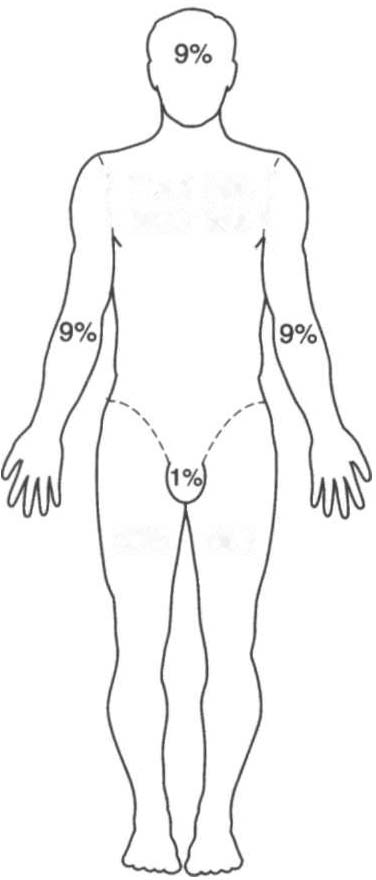i bc27f85be50b71b1 (136 page)
Read i bc27f85be50b71b1 Online
Authors: Unknown

thickness burns.
liquid, such as
Exposure ro thicker liquids or
boiling water,
immersion causes a deeper burn
grease, or tar
from increased contact time.
Immersion burns commonly cover a
larger total body surface area than
do spills.
Flame burn
Flame exposure
Often causes superficial and deep
from fire or
partial-thickness burns.
flammable
Associated with carbon monoxide
liquids, or
poisoning.
ignition of
ciorhing
Flash burn
Explosion of
Often causes partial-thickness burns.
flammable
Burns may be distribured over all
liquid, such as
exposed skin.
gasoline or
Associated with upper airway thermal
propane
damage.
Most common in the summer and
associated with [he consumption of
alcohol.
Contact burn
Exposure to hot
Often causes deep partial- or fullobjects, such as
thickness burns.
glass, plastic,
Associated with crushing injuries,
mecal, or coal
such as moror vehicle accidents.
Most common cause of serious burns
in the elderly.
Sources: Data from GO Warden, OM Heimbach. Burns. In SI Schwartz (ed), Principles
of Surgery, Vol. 1 (7th ed). New York: McGraw-Hili, 1999; and RF Edlich, JC Moghrader. Thermal Burns. In P Rosen (cd), Emergency Medicine Concepts and Clinical Practice, Vol. I (4th cd). Sr. Louis: Mosby, 1998.
damage accounts for the high incidence of amputation associated
with electrical injury.'" The severity of an electrical burn depends
primarily on the duration of contact with the source, as well as the
voltage of the source, rhe type and parhway of currenr, and the
amperage and resistance through the body tissues·


BURNS AND WOUNDS 443
Electrical burns are characterized by deep entrance and exit
wounds or arc wounds. The entrance wound is usually an obvious
necrotic and depressed area, whereas the exit wound varies in presentation. The exit wOllnd can be a single wound or multiple wounds located where the patient was grounded during injury.7 An
arc wOllnd is caused by the passage of current directly between
joints in close opposition. For example, if the elbow is fully flexed
and an electrical current passes through the arm, burns may be
located at the volar aspect of the wrist, antecubital space, and
axilla.'
Complications specific to electrical injury include the following"s:
• Cardiovascular: Cardiac arrest (ventricular fibrillation for electric current or asystolic for lightning), arrhythmia (usually sinus tachycardia or nonspecific ST changes) secondary to alterations in
electrical conductivity of the heart, myocardial contusion or infarction, or heart wall or papillary muscle rupture
• Neurologic: Headache, seizure, brief loss of consciousness or
coma, peripheral nerve injury (resulting from ischemia), spinal
cord paralysis (from demyelination), herniated nucleus pulposus,
or decreased attention and concentration
•
Orthopedic: Dislocations or fractures secondary to sustained
muscular contraction or from a fall during the burn injury
• Other: Visceral perforation or necrosis, cataracts, tympanic
membrane rupture, anxiety, depression, or post-traumatic stress
disorder
Lightning
Lightning, considered a form of very high electrical current, causes
injury via four mechanisms9:
1.
Direct strike, in which the person is the grounding site
2.
Flash discharge, in which an object deviates the course of
the lightning current before striking the person
3.
Ground current, in which lightning strikes the ground
and a person within the grounding area creates a pathway for the
current


444 AClITE CARE HANDBOOK FOR PHYSICAL n-iERAI}ISTS
4.
Shock wave, in which lightning travels outside the person
and static electricity vaporizes moisture in the skin
Chemical Burns
Chemical burns can be the result of reduction, oxidation, corrosion, or
desecration of body tissue with or without an associated thermal injury.lo
The severity of burn depends on the type of chemical and its concentration, duration of contact, and mechanism of action. Unlike thermal burns, chemical burns significantly alter systemic tissue pH and metabolism. These changes can cause serious pulmonary complications (e. g. , airway obstruction from bronchospasm, edema, or epithelial sloughing) and metabolic complications (e. g., liver necrosis or renal dysfunction
from prolonged chemical exposure).
Ultraviolet and Ionizing Radiation Burns
A sunbun1 is a superficial partial-thickness burn from the overexposure
of the skin to UV radjation. Ionizing radiation burns with or without
thermal burn occur when electromagnetic or particulate radiation energy
is transferred [Q body tissues, resulting in the formation of chemical free
radicals. I I Ionizing radiation burns usually occur in laboratory or industrial settings. The severity of the ionizing radiation burn depends on the dose, dose ra te, and the tissue sensitivity of exposed cells. Often referred
to as acute radiation syndrome, complications of ionizing radiation
burns include the following I L
• Gastrointestinal: Cramps, nausea, vomiting, diarrhea, and bowel
i chemia
•
Hematologic: Pancytopenia (decreased number of red blood cells,
white blood cells, and platelets), granulocytopenia (decreased number
of granular leukocytes), thrombocytopenia (decreased number of
platelets), and hemorrhage
• Vascular: Endothelium destruction
Burn Assessment and Acute Care Management
of Burn lnjury
Classificatioll of a Bllm
The extent and depth of the burn determine its severity and dictate
acute care treatment.


BURNS AND WOUNDS 445
Assessing the Extent of a Burn
The accurate assessment of the extent of a burn is necessary to calculate
fluid volume therapy and is a predictor of morbidity.
12 The extent of a
burn injury is referred to as total body sur(ace area (TBSA) and can be
calculated by the rule of nines or the Lund and Browder formula.
Rille o( Nilles
The rule of nines divides the body into sections, seven of which are
assigned 9% of TBSA. The anterior and posterior trunk are each
assigned 18%, and the genitalia is assigned 1% (Figure 7-4). This
\ Front 18% !
\ Back 18% :
18%
18%
Figure 7-4. The rule of nines method of assessing the extent of a bum injury.
(\vith permission (rom M \Valsh led!, Nurse Practitioners: Clinical Skills and
Pro(essionallssltes. Oxford, UK: Butterworth-Heinemann, 1999;32.)

